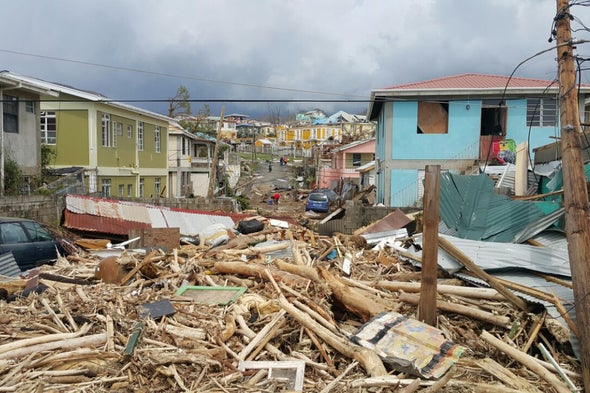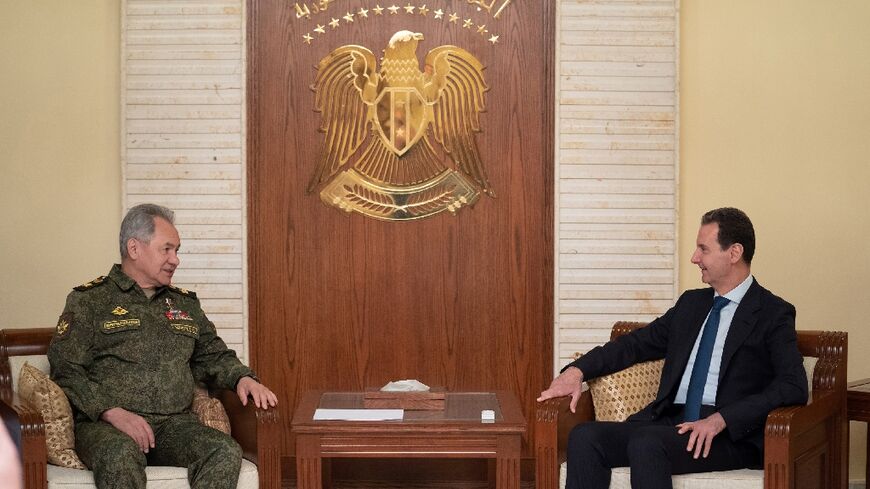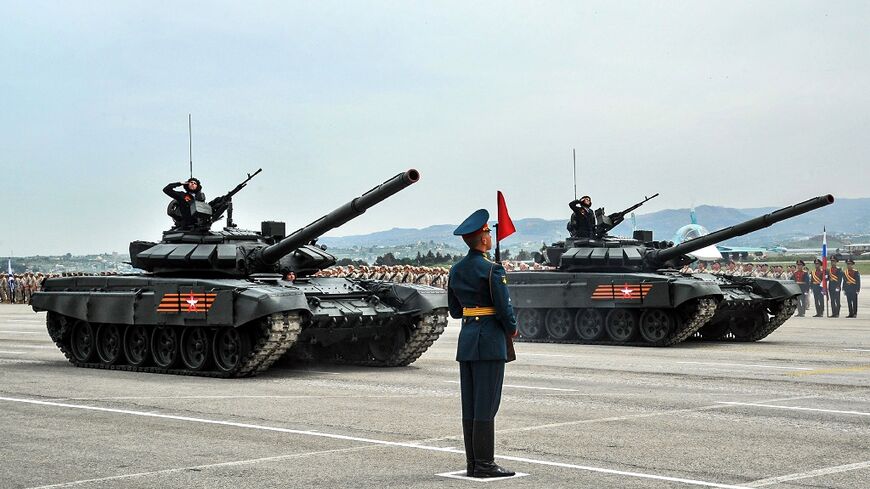With ‘Limited Amount of Time Left,’ New IPCC Report Urges Climate Adaptation
Human and natural systems are already buckling under the influence of global warming, write the authors of a landmark report
By Chelsea Harvey, Sara Schonhardt, E&E News on February 28, 2022

Hurricane Maria damage in Roseau, Dominica, in September 2017.
Credit: STR/AFP via Getty Images
The lowly Bramble Cay melomys, a small Australian rodent, wasn’t the kind of animal that often made the news. But in 2019, it splashed across headlines.
The reason? It was the first mammal to go extinct because of climate change.
Named for the island where it used to live, the little rodent had been declining for decades. Scientists had warned for several years beforehand that it was either already extinct or nearly there, blaming its demise on a combination of sea-level rise and increasing tropical storms.
Now almost certainly gone, the Bramble Cay melomys is a grim reminder that some consequences of climate change are forever—and that some of these irreversible impacts are happening today.
Those warnings are among the stark messages contained in a landmark climate report released today by the U.N. Intergovernmental Panel on Climate Change, composed of the world’s leading climate scientists. A rapidly warming world will hit humans and nature harder than expected, the report warns—and we’re far from prepared to deal with the fallout.
U.N. Secretary-General António Guterres called the report “an atlas of human suffering and a damning indictment of failed climate leadership.”
“With fact upon fact, this report reveals how people and the planet are getting clobbered by climate change,” he said.
The report is the latest of three in a major ongoing climate assessment by the IPCC—the sixth since the organization was established more than 30 years ago. The first installment in August, which focused on changes to the atmosphere, water and land, found that the window for limiting temperature rise to dangerous levels was nearly closed and that some of the shifts now in motion—such as sea-level rise—are irreversible (Climatewire, Aug. 9, 2021).
Today’s report focuses on how those physical changes will affect humans and natural ecosystems, and the ability of both to respond to what’s coming.
Its primary takeaways include a mix of warning and hope. Human and natural systems already are buckling under the influence of global warming. Some of them are approaching the limits of their ability to adapt. Some of them will be changed forever and won’t be able to bounce back—even if rising temperatures eventually recede.
But it’s not all doom and gloom. Some places around the world still have time to put measures in place that can help them adapt to more extreme heat, severe storms, drought and flooding. But that will require more money and resources, better policies, understanding and involvement of local communities—and all of it without delay.
The Bramble Cay melomys is hardly the only irretrievable casualty of the warming world. Weather and climate extremes already have left some irreversible impacts as human and natural systems are pushed beyond their ability to respond, the report states.
Hundreds of other species around the world have gone locally extinct—not disappearing from the globe entirely but vanishing from some regions they used to call home. Some islands and other coastal areas are slipping beneath the rising seas, likely for good.
Within the last decade, residents of Louisiana’s rapidly shrinking island community of Isle de Jean Charles—many of whom belong to the Biloxi-Chitimacha-Choctaw tribe—have become widely recognized as the first U.S. climate refugees. Elsewhere around the world, entire island nations are facing the prospect of forced relocation as their homes disappear beneath the swelling ocean.
Many ecosystems that haven’t yet passed the point of no return are approaching the brink. Mass mortality events are plaguing forests and coral reefs around the world. Permafrost is thawing across the Arctic, releasing large quantities of carbon dioxide and methane, degrading the landscape and threatening buildings and other infrastructure. Mountain glaciers are melting and shrinking, threatening local water supplies.
And around the world, human suffering is increasing as global temperatures rise.
Wildfires, droughts, floods, hurricanes and other extreme weather events are growing more intense. Food and water insecurity is rising, particularly across parts of Asia, Africa, Central and South America and small islands. Malnutrition is affecting more children and expectant mothers. Small-scale farmers and fishermen are losing their livelihoods.
Extreme heat is killing people and damaging vital infrastructure, such as roads and power systems. Heat waves have reduced people’s ability to work outdoors in some places. Severe storms have dented or even decimated economic growth in countries that can often least afford to lose it.
And it will only get worse with each fraction of a degree of warming.
“We simultaneously need to reduce our greenhouse gas emissions, adapt to reduce the risks of climate change and also address losses and damages that are already being experienced,” said Adelle Thomas, a scientist at Climate Analytics and the University of the Bahamas and a co-author of the report. “And we have a very limited amount of time left to do this.”
‘MUCH MORE NEGATIVE THAN EXPECTED’
The world has warmed by just over 1 degree Celsius (that’s nearly 2 degrees Fahrenheit) since the onset of the Industrial Revolution, when humans began rapidly pumping greenhouse gases into the atmosphere. It doesn’t sound like much, but that small amount of warming already has wreaked havoc on Earth’s climate system.
“One of the most striking conclusions in our report is that we’re seeing adverse impacts as being much more widespread and being much more negative than expected in prior reports, than expected at the current 1.09 degrees that we have,” said Camille Parmesan, an ecologist at the University of Texas, Austin, and a co-author of the IPCC report.
The report, which synthesizes thousands of recent climate studies, reveals that some climate consequences are happening faster than scientists had expected at this level of warming.
Infectious diseases are spreading into new parts of the globe. Species are going extinct. Ecosystems are dramatically transforming.
Already, between 3.3 billion and 3.6 billion people around the world—nearly half the global population—are “highly vulnerable” to the impacts of climate change, the report finds. Climate change is taking its toll on both the physical and mental health of communities all over the world.
The findings suggest that even small amounts of future warming may have dire consequences for the planet, Parmesan noted.
In another half-degree Celsius, the world will exceed the 1.5 C warming threshold, the most ambitious target of the Paris climate agreement. If that happens, the report states, “then many human and natural systems will face additional severe risks,” including a growing danger of irreversible climate consequences.
Climate impacts around the world will grow even worse with additional warming. That’s a distinct possibility if global climate action doesn’t accelerate. At the moment, the climate policies enacted by world leaders put the world on track for around 3 degrees of warming by the end of the century.
“The good news is that the IPCC makes clear that we can limit the extent to which these climate impacts worsen if we meet the Paris targets, but so far the world—including the US—is not on track to meet those pledges,” said Dana Nuccitelli, a research coordinator with the nonprofit Citizens’ Climate Lobby, in an email to E&E News.
In land-based ecosystems, for instance, anywhere from 3 percent to 14 percent of all species may face a high risk of extinction at 1.5 C of warming. At 2 C, up to 18 percent may be threatened. At 3 C, it’s up to 29 percent—and the risk continues to grow with additional warming.
Sea-level rise will worsen as temperatures climb. And the coastal populations exposed to severe floods will increase as a result.
Both extreme rainfall events and severe drought are likely to increase in many places around the world. At 4 C of warming, around 10 percent of the entire global land area is likely to face a growing likelihood of both high river flows, increasing the risk of floods, and low river flows, increasing the risk of water shortages.
Hurricanes will grow more severe, likely causing more damage when they strike coastal communities. Wildfires will likely burn more land.
More people around the globe will suffer from extreme heat events. Heat is already the leading cause of weather-related death in the United States, and studies suggest it may cause hundreds of thousands of excess deaths around the world each year.
And food and water insecurity will continue to rise, as agriculture suffers and freshwater resources dwindle on a warming planet.
These impacts don’t affect all populations equally today, and they won’t in the future either. Certain parts of the world—particularly developing countries, small island nations and countries in tropical regions—are disproportionately at risk from many climate consequences, especially the effects of extreme heat and food and water insecurity.
And in nations all across the globe, including the United States, some populations are more vulnerable than others. These include lower-income communities, Indigenous communities and people of color, unhoused populations, and the elderly.
“Effective actions are those that reduce climate impacts and risks,” said Edwin Castellanos, a scientist at the University of the Valley of Guatemala and a co-author of the report. “And because these risks are different for different people, effective solutions need to provide site-specific actions. Putting vulnerable groups and countries at the heart of the decision-making process of how we respond to climate change can make societies more resilient.”
ADAPTATION: ‘CRITICAL TO OUR SURVIVAL’
Efforts to respond to climate impacts have improved and expanded. That’s particularly true for measures around water-related risks, such as the building of levees, early warning systems for flooding, wetland restoration and farm-based water management, the report states.
But progress on adaptation is uneven, driven in part by a lack of money needed to fund such efforts in places that face the greatest damage from rising temperatures.
Most adaptation efforts so far have been piecemeal and incremental—focused on reducing immediate climate risks rather than putting in place measures for long-term, transformational change, the report states.
They’re also small in scale and focused more on planning than implementation. And because those initiatives are geared toward current hazards, they are limited in their effectiveness as climate risks grow. And the warmer the world gets, the harder it becomes to adapt.
The report also finds that the gap between current adaptation efforts and what’s needed is widening and will only widen further if more action isn’t taken.
But there are feasible and effective adaptation options, according to the report. Heat health action plans can warn people of extreme temperatures and help protect them from exposure to prevent heat-related deaths. Restoring degraded forests can help them take in excess carbon rather than emit it. Protecting coastal or marine ecosystems, or creating corridors where threatened species can move to safer spaces, can help their survival.
But adaptation cannot prevent all the negative impacts of climate change, said Thomas, the Climate Analytics scientist and author.
In low-lying coastal communities, for example, the increasing intensity of tropical storms and hurricanes combined with sea-level rise will lead to losses that are irreparable. And the poorest and most vulnerable communities will be hit hardest, she said.
For some measures, such as water management, there is no amount of money or government support that can help with adaptation when there is no more water available.
The ability for human populations to respond to rising temperatures and try to hold them to the 1.5-degree limit also will depend on making sure natural systems are still capable of sucking carbon emissions from the atmosphere because reductions alone won’t be enough, said Parmesan from the University of Texas, Austin.
Yet the vast majority of climate finance goes toward efforts to reduce emissions, such as investments in clean energy infrastructure, rather than adaptation, Thomas said.
Another challenge? As climate damage dents economic growth, it can be harder for low-income countries to access the money needed to respond.
“Adaptation is critical to our survival in the face of climate change, but current financing schemes are underfunded and inaccessible to the majority of [small island developing states],” Gaston Browne, prime minister of Antigua and Barbuda, which holds the chair of the Alliance of Small Island States, said in a statement.
“The solutions are there, the report shows that adaptation works. It is particularly clearer now, given the implications and vulnerability outlined in this report, that financing for loss and damage is more crucial now than ever,” Browne added.
World leaders will gather in Egypt toward the end of this year to hammer out ways to respond faster and more effectively to impacts like those outlined in the report. Previous reports have served as the foundation for targets like the 1.5-degree temperature limit included in the Paris agreement.
U.S. climate envoy John Kerry said in a statement that while emissions reductions will continue to be crucial, “we must expand and expedite adaptation action.”
That matters since there also are limits to human adaptation—largely due to a lack of money and policies needed to support it. Those “soft limits” are currently playing out in low-lying coastal areas and among small-holder farmers who don’t have the resources to adapt further and will incur additional negative impacts from climate change as a result, Thomas said.
For coastal communities, what that means in practice is that installing sea walls, putting in sand dunes or restoring coral reefs or wetlands no longer will be financially feasible or may no longer be technically feasible, she explained.
But they can be overcome.
“If we put more resources toward adaptation, then additional adaptation options will open up,” Thomas said.
Time isn’t the only obstacle, either. Many countries that most need to respond to climate impacts are striving to develop and meet the needs of growing populations with limited resources. The report aims to show that adaptation and lower emissions can help with sustainable development.
But that will require increased international cooperation, especially a greater commitment to providing finance—which the report finds is currently insufficient—and also ensuring vulnerable countries have access to it.
It also will involve planning to respond to climate impacts when adaptation is no longer an option, such as relocating coastal communities when homes and livelihoods are eaten away by unstoppable rising tides.
Since the last report, there is further evidence that some adaptation can lead to unintended consequences that worsen the impacts of climate change—what’s known as maladaptation.
Examples include firefighting efforts in ecosystems that are adapted to fire and rely on it to prevent outbreaks of larger blazes or hard infrastructure that doesn’t allow for water runoff and can increase the likelihood of flooding. Sea walls that might protect coastal communities today might damage coral reef ecosystems offshore.
Maladaptation can exacerbate inequality and put communities at further risk, and it can be expensive to undo, the report states. What’s needed to avoid it is long-term planning that takes into account local contexts and works to integrate solutions across different areas.
“It really requires a systemic, comprehensive response—not just a piecemeal, standalone series of projects. [It takes] really thinking about how does the economy, climate resilience, food security, health all intersect and how a better understanding of climate change reshaping all of those sectors can help us build a more resilient, just and fair future,” said Shyla Raghav, vice president of climate change at Conservation International.
For adaptation to work, government support will be needed, the report finds. So too will clear, defined policies, better understanding of both climate impacts and solutions and access to the money to make them realities. Involving vulnerable communities, drawing on Indigenous knowledge and committing to climate justice is also vital, according to the report.
The fact that IPCC reports are endorsed by governments and provided to policymakers gives weight to their findings. And they do help influence policy, said Rachel Licker, a senior climate scientist at the Union of Concerned Scientists.
But so far it hasn’t been enough.
“We’ve had these reports coming out for decades, and we’ve known what the causes are, we know what the solutions are, and we’re just not implementing them,” Licker said.
Despite the dire conclusions, ramping up action could be harder at a time when the world remains locked in a global pandemic and as war embroils Ukraine, threatening stability in Europe.
“We will always have emergencies at hand that seem to be more urgent than climate change,” said Castellanos of the University of the Valley of Guatemala.
But that’s no reason to delay, he added.
“We need to start addressing these problems of climate change,” he said. “Otherwise it’s going to be more complicated or even impossible to do so in the future.”
Reprinted from E&E News with permission from POLITICO, LLC. Copyright 2022. E&E News provides essential news for energy and environment professionals.















